clutch Alfa Romeo MiTo 2016 Owner's Manual
[x] Cancel search | Manufacturer: ALFA ROMEO, Model Year: 2016, Model line: MiTo, Model: Alfa Romeo MiTo 2016Pages: 280, PDF Size: 8.52 MB
Page 6 of 280

VERY IMPORTANT
REFUELLING
Petrol engines: only refuel with unleaded petrol with
octane rating (RON) not less than 95 in compliance with the
European Standard EN228.
Diesel engines: refuel only with diesel fuel conforming to
the European specification EN590. The use of other products
or mixtures may damage the engine beyond repair and
consequently invalidate the warranty, due to the damage
caused.
STARTING THE ENGINE
Petrol engines: make sure that the handbrake is engaged,
set the gear lever to neutral, fully depress the clutch without
depressing the accelerator, then turn the ignition key to AVV
and release it as soon as the engine has started.
Diesel engines: turn the ignition key to MAR and wait for
the warning lights
andto go out; then turn the
ignition key to AVV and release it as soon as the engine has
started.
PARKING ON FLAMMABLE MATERIAL
The catalytic converter develops high temperatures during
operation. Do not park the car on grass, dry leaves, pine
needles or other flammable material: fire hazard.
RESPECTING THE ENVIRONMENT
The car is fitted with a system that carries out a continuous
diagnosis of the emission-related components in order to help
protect the environment.
ELECTRICAL ACCESSORIES
If after having purchased the car you decide to add
accessories requiring electricity (with the risk of gradually
draining the battery), contact Alfa Romeo Authorized
Services. They can calculate the overall electric requirement
and check that the car's electric system can support the
required load.
CODE card
(for versions/markets, where provided)
Keep it in a safe place, not in the car. We recommend that
you always carry the electronic code provided on the CODE
card with you, in case you need to perform an emergency
start.
SCHEDULED SERVICING
Correct maintenance of the car is essential for ensuring that it
maintains its performance and its safety features, its
environmental friendliness and low running costs for a long
time to come.
THE OWNER MANUAL CONTAINS…
...important information, advice and warnings for correct use,
driving safety and maintenance of your car over time.
Particular attention should be paid to information marked
with the following symbols:
(personal safety)(environmental protection)(car integrity).
Page 69 of 280
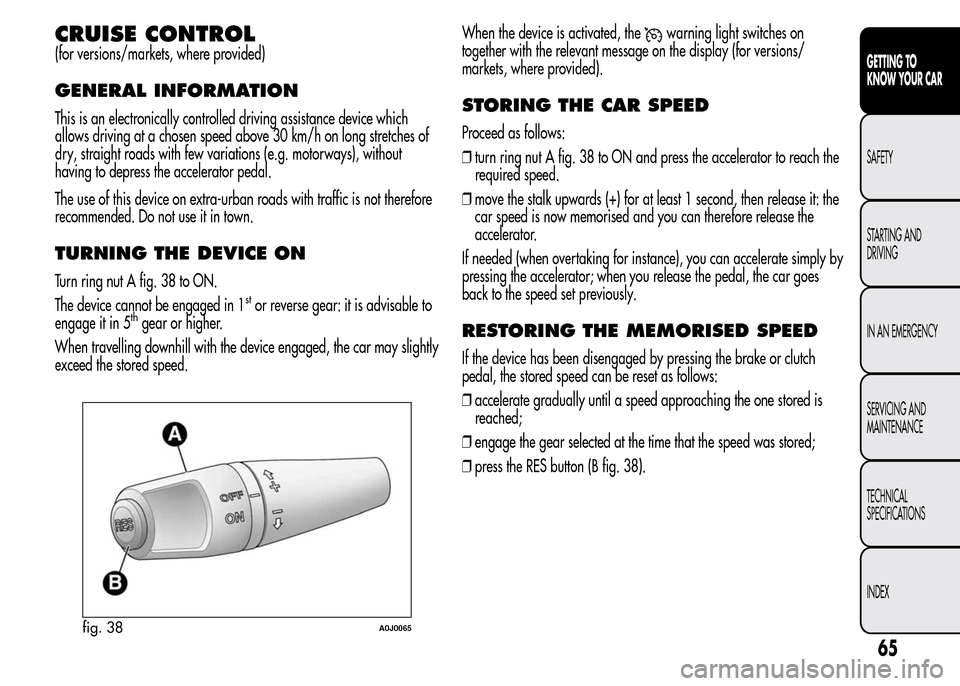
CRUISE CONTROL
(for versions/markets, where provided)
GENERAL INFORMATION
This is an electronically controlled driving assistance device which
allows driving at a chosen speed above 30 km/h on long stretches of
dry, straight roads with few variations (e.g. motorways), without
having to depress the accelerator pedal.
The use of this device on extra-urban roads with traffic is not therefore
recommended. Do not use it in town.
TURNING THE DEVICE ON
Turn ring nut A fig. 38 to ON.
The device cannot be engaged in 1
stor reverse gear: it is advisable to
engage it in 5thgear or higher.
When travelling downhill with the device engaged, the car may slightly
exceed the stored speed.When the device is activated, the
warning light switches on
together with the relevant message on the display (for versions/
markets, where provided).
STORING THE CAR SPEED
Proceed as follows:
❒turn ring nut A fig. 38 to ON and press the accelerator to reach the
required speed.
❒move the stalk upwards (+) for at least 1 second, then release it: the
car speed is now memorised and you can therefore release the
accelerator.
If needed (when overtaking for instance), you can accelerate simply by
pressing the accelerator; when you release the pedal, the car goes
back to the speed set previously.
RESTORING THE MEMORISED SPEED
If the device has been disengaged by pressing the brake or clutch
pedal, the stored speed can be reset as follows:
❒accelerate gradually until a speed approaching the one stored is
reached;
❒engage the gear selected at the time that the speed was stored;
❒press the RES button (B fig. 38).
fig. 38A0J0065
65
GETTING TO
KNOW YOUR CAR
SAFETY
STARTING AND
DRIVING
IN AN EMERGENCY
SERVICING AND
MAINTENANCE
TECHNICAL
SPECIFICATIONS
INDEX
Page 70 of 280
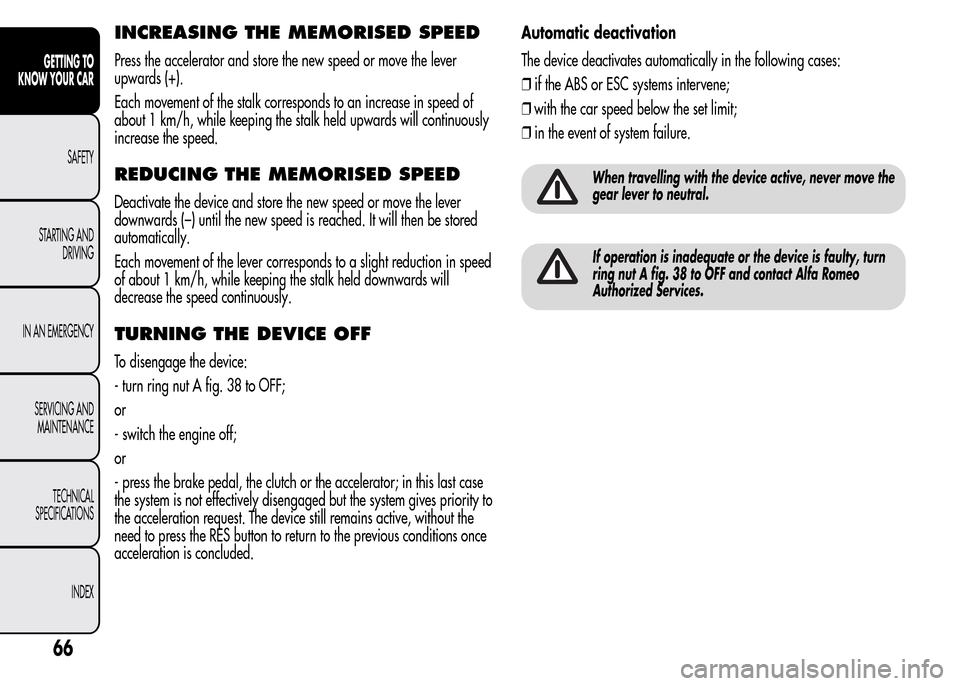
INCREASING THE MEMORISED SPEED
Press the accelerator and store the new speed or move the lever
upwards (+).
Each movement of the stalk corresponds to an increase in speed of
about 1 km/h, while keeping the stalk held upwards will continuously
increase the speed.
REDUCING THE MEMORISED SPEED
Deactivate the device and store the new speed or move the lever
downwards (–) until the new speed is reached. It will then be stored
automatically.
Each movement of the lever corresponds to a slight reduction in speed
of about 1 km/h, while keeping the stalk held downwards will
decrease the speed continuously.
TURNING THE DEVICE OFF
To disengage the device:
- turn ring nut A fig. 38 to OFF;
or
- switch the engine off;
or
- press the brake pedal, the clutch or the accelerator; in this last case
the system is not effectively disengaged but the system gives priority to
the acceleration request. The device still remains active, without the
need to press the RES button to return to the previous conditions once
acceleration is concluded.Automatic deactivation
The device deactivates automatically in the following cases:
❒if the ABS or ESC systems intervene;
❒with the car speed below the set limit;
❒in the event of system failure.
When travelling with the device active, never move the
gear lever to neutral.
If operation is inadequate or the device is faulty, turn
ring nut A fig. 38 to OFF and contact Alfa Romeo
Authorized Services.
66
GETTING TO
KNOW YOUR CAR
SAFETY
STARTING AND
DRIVING
IN AN EMERGENCY
SERVICING AND
MAINTENANCE
TECHNICAL
SPECIFICATIONS
INDEX
Page 99 of 280

START&STOP SYSTEM
(for versions/markets, where provided)
The Start&Stop system automatically stops the engine each time the car
is stationary and starts it again when the driver wants to move off.
In this way, the efficiency of the car is increased, by reducing
consumption, emissions of harmful gases and noise pollution.
OPERATING MODES
Engine stopping mode
With the car stopped, the engine stops with gearbox in neutral and
clutch pedal released.
NoteThe engine can only be stopped automatically over about 10
km/h, to prevent the engine from being repeatedly stopped when
driving at walking pace.
The
fig. 80 symbol appears on the display when the engine stops.
Restarting the engine
Press the clutch pedal to restart the engine.
SYSTEM MANUAL ACTIVATION/
DEACTIVATION
To activate/deactivate manually the system, press thefig. 81 button
on the trim next to the steering wheel.
Start&Stop system activation
A message and a symbol will be displayed when the Start&Stop
system is activated.
Turning the Start&Stop off
❒Versions with multifunction display:a message is displayed when the
Start&Stop system is deactivated.
❒Versions with reconfigurable multifunction display:the
symbol is
displayed + a message when the Start&Stop system is deactivated.
fig. 80A0J0279fig. 81A0J0307
95
GETTING TO
KNOW YOUR CAR
SAFETY
STARTING AND
DRIVING
IN AN EMERGENCY
SERVICING AND
MAINTENANCE
TECHNICAL
SPECIFICATIONS
INDEX
When the system is deactivated, thewarning light on the instrument
panel switches on. For versions/markets where provided, a message
and symbol are also displayed in the event of system activation/
deactivation.
Page 100 of 280
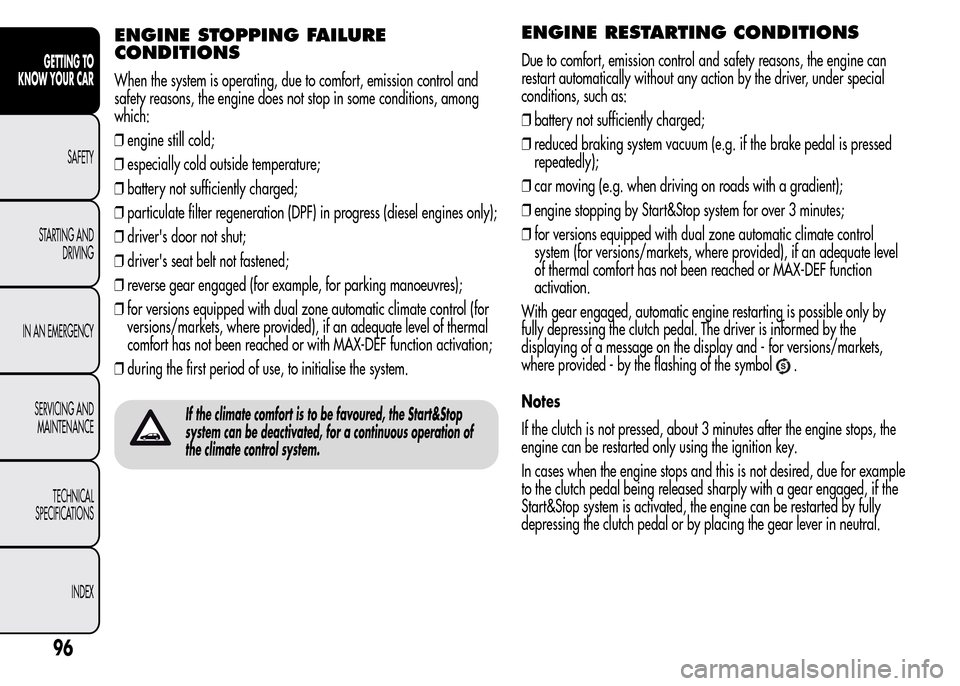
ENGINE STOPPING FAILURE
CONDITIONS
When the system is operating, due to comfort, emission control and
safety reasons, the engine does not stop in some conditions, among
which:
❒engine still cold;
❒especially cold outside temperature;
❒battery not sufficiently charged;
❒particulate filter regeneration (DPF) in progress (diesel engines only);
❒driver's door not shut;
❒driver's seat belt not fastened;
❒reverse gear engaged (for example, for parking manoeuvres);
❒for versions equipped with dual zone automatic climate control (for
versions/markets, where provided), if an adequate level of thermal
comfort has not been reached or with MAX-DEF function activation;
❒during the first period of use, to initialise the system.
If the climate comfort is to be favoured, the Start&Stop
system can be deactivated, for a continuous operation of
the climate control system.
ENGINE RESTARTING CONDITIONS
Due to comfort, emission control and safety reasons, the engine can
restart automatically without any action by the driver, under special
conditions, such as:
❒battery not sufficiently charged;
❒reduced braking system vacuum (e.g. if the brake pedal is pressed
repeatedly);
❒car moving (e.g. when driving on roads with a gradient);
❒engine stopping by Start&Stop system for over 3 minutes;
❒for versions equipped with dual zone automatic climate control
system (for versions/markets, where provided), if an adequate level
of thermal comfort has not been reached or MAX-DEF function
activation.
With gear engaged, automatic engine restarting is possible only by
fully depressing the clutch pedal. The driver is informed by the
displaying of a message on the display and - for versions/markets,
where provided - by the flashing of the symbol
.
Notes
If the clutch is not pressed, about 3 minutes after the engine stops, the
engine can be restarted only using the ignition key.
In cases when the engine stops and this is not desired, due for example
to the clutch pedal being released sharply with a gear engaged, if the
Start&Stop system is activated, the engine can be restarted by fully
depressing the clutch pedal or by placing the gear lever in neutral.
96
GETTING TO
KNOW YOUR CAR
SAFETY
STARTING AND
DRIVING
IN AN EMERGENCY
SERVICING AND
MAINTENANCE
TECHNICAL
SPECIFICATIONS
INDEX
Page 134 of 280
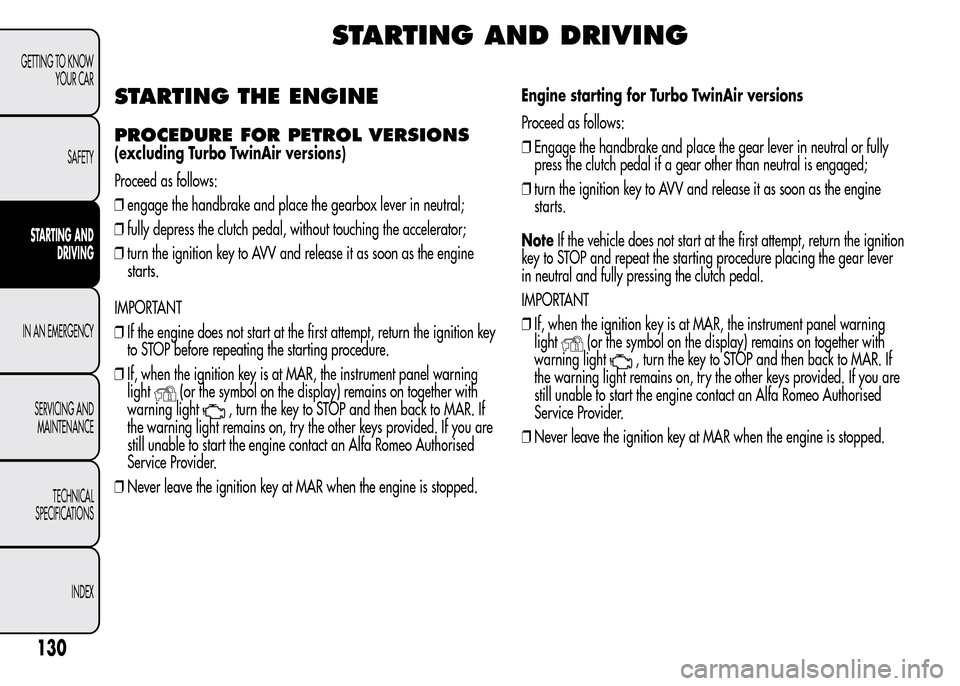
STARTING AND DRIVING
STARTING THE ENGINE
PROCEDURE FOR PETROL VERSIONS
(excluding Turbo TwinAir versions)
Proceed as follows:
❒engage the handbrake and place the gearbox lever in neutral;
❒fully depress the clutch pedal, without touching the accelerator;
❒turn the ignition key to AVV and release it as soon as the engine
starts.
IMPORTANT
❒If the engine does not start at the first attempt, return the ignition key
to STOP before repeating the starting procedure.
❒If, when the ignition key is at MAR, the instrument panel warning
light
(or the symbol on the display) remains on together with
warning light
, turn the key to STOP and then back to MAR. If
the warning light remains on, try the other keys provided. If you are
still unable to start the engine contact an Alfa Romeo Authorised
Service Provider.
❒Never leave the ignition key at MAR when the engine is stopped.Engine starting for Turbo TwinAir versions
Proceed as follows:
❒Engage the handbrake and place the gear lever in neutral or fully
press the clutch pedal if a gear other than neutral is engaged;
❒turn the ignition key to AVV and release it as soon as the engine
starts.
NoteIf the vehicle does not start at the first attempt, return the ignition
key to STOP and repeat the starting procedure placing the gear lever
in neutral and fully pressing the clutch pedal.
IMPORTANT
❒If, when the ignition key is at MAR, the instrument panel warning
light
(or the symbol on the display) remains on together with
warning light
, turn the key to STOP and then back to MAR. If
the warning light remains on, try the other keys provided. If you are
still unable to start the engine contact an Alfa Romeo Authorised
Service Provider.
❒Never leave the ignition key at MAR when the engine is stopped.
130
GETTING TO KNOW
YOUR CAR
SAFETY
STARTING AND
DRIVING
IN AN EMERGENCY
SERVICING AND
MAINTENANCE
TECHNICAL
SPECIFICATIONS
INDEX
Page 135 of 280
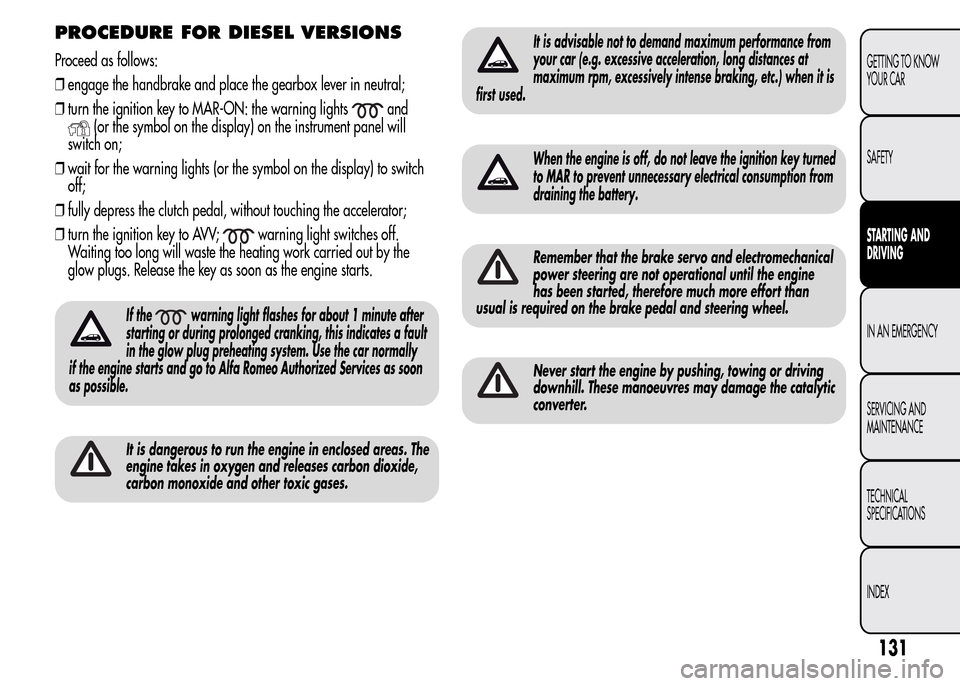
PROCEDURE FOR DIESEL VERSIONS
Proceed as follows:
❒engage the handbrake and place the gearbox lever in neutral;
❒turn the ignition key to MAR-ON: the warning lights
and
(or the symbol on the display) on the instrument panel will
switch on;
❒wait for the warning lights (or the symbol on the display) to switch
off;
❒fully depress the clutch pedal, without touching the accelerator;
❒turn the ignition key to AVV;
warning light switches off.
Waiting too long will waste the heating work carried out by the
glow plugs. Release the key as soon as the engine starts.
If thewarning light flashes for about 1 minute after
starting or during prolonged cranking, this indicates a fault
in the glow plug preheating system. Use the car normally
if the engine starts and go to Alfa Romeo Authorized Services as soon
as possible.
It is dangerous to run the engine in enclosed areas. The
engine takes in oxygen and releases carbon dioxide,
carbon monoxide and other toxic gases.
It is advisable not to demand maximum performance from
your car (e.g. excessive acceleration, long distances at
maximum rpm, excessively intense braking, etc.) when it is
first used.
When the engine is off, do not leave the ignition key turned
to MAR to prevent unnecessary electrical consumption from
draining the battery.
Remember that the brake servo and electromechanical
power steering are not operational until the engine
has been started, therefore much more effort than
usual is required on the brake pedal and steering wheel.
Never start the engine by pushing, towing or driving
downhill. These manoeuvres may damage the catalytic
converter.
131
GETTING TO KNOW
YOUR CAR
SAFETY
STARTING AND
DRIVING
IN AN EMERGENCY
SERVICING AND
MAINTENANCE
TECHNICAL
SPECIFICATIONS
INDEX
Page 137 of 280

HANDBRAKE
To engage the handbrake pull lever A fig. 111 upwards until the car is
secured. To release the handbrake, raise lever A slightly, hold down
button B and lower the lever.
IMPORTANT Carry out these manoeuvres with the brake pedal
pressed.
IMPORTANT For cars equipped with a front armrest, lift this up to
ensure that it does not interfere with the action of the handbrake.
The car should be locked after a few notches: if this is
not the case, contact Alfa Romeo Authorized Services
to have the handbrake adjusted.
USING THE GEARBOX
To engage the gears, fully depress the clutch pedal and put the gear
lever into the desired position (the diagram for gear engagement
is shown on the knob of the lever fig. 112, fig. 113, fig. 114).
fig. 111A0J0110
fig. 112A0J0265
fig. 113A0J0266
133
GETTING TO KNOW
YOUR CAR
SAFETY
STARTING AND
DRIVING
IN AN EMERGENCY
SERVICING AND
MAINTENANCE
TECHNICAL
SPECIFICATIONS
INDEX
Page 138 of 280
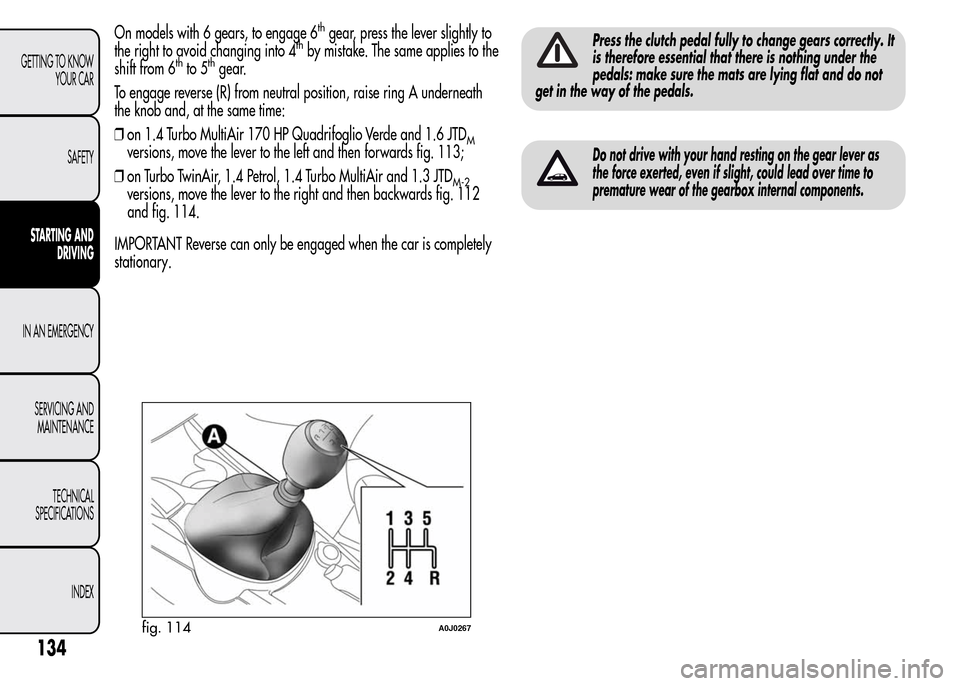
On models with 6 gears, to engage 6thgear, press the lever slightly to
the right to avoid changing into 4thby mistake. The same applies to the
shift from 6thto 5thgear.
To engage reverse (R) from neutral position, raise ring A underneath
the knob and, at the same time:
❒on 1.4 Turbo MultiAir 170 HP Quadrifoglio Verde and 1.6 JTD
Mversions, move the lever to the left and then forwards fig. 113;
❒on Turbo TwinAir, 1.4 Petrol, 1.4 Turbo MultiAir and 1.3 JTD
M-2versions, move the lever to the right and then backwards fig. 112
and fig. 114.
IMPORTANT Reverse can only be engaged when the car is completely
stationary.
Press the clutch pedal fully to change gears correctly. It
is therefore essential that there is nothing under the
pedals: make sure the mats are lying flat and do not
get in the way of the pedals.
Do not drive with your hand resting on the gear lever as
the force exerted, even if slight, could lead over time to
premature wear of the gearbox internal components.
fig. 114A0J0267
134
GETTING TO KNOW
YOUR CAR
SAFETY
STARTING AND
DRIVING
IN AN EMERGENCY
SERVICING AND
MAINTENANCE
TECHNICAL
SPECIFICATIONS
INDEX
Page 139 of 280
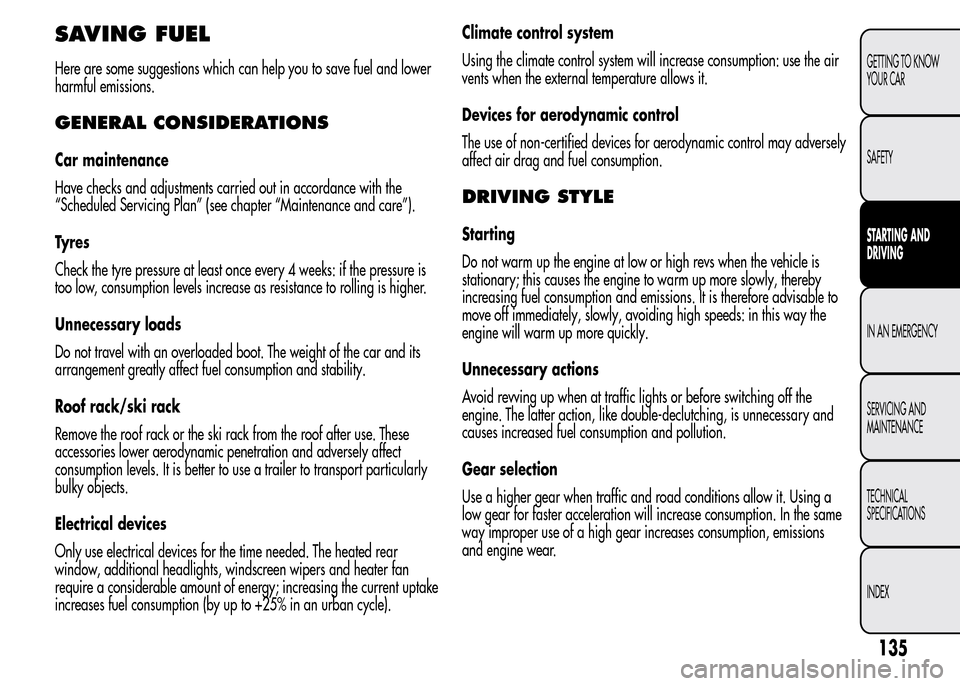
SAVING FUEL
Here are some suggestions which can help you to save fuel and lower
harmful emissions.
GENERAL CONSIDERATIONS
Car maintenance
Have checks and adjustments carried out in accordance with the
“Scheduled Servicing Plan” (see chapter “Maintenance and care”).
Ty r e s
Check the tyre pressure at least once every 4 weeks: if the pressure is
too low, consumption levels increase as resistance to rolling is higher.
Unnecessary loads
Do not travel with an overloaded boot. The weight of the car and its
arrangement greatly affect fuel consumption and stability.
Roof rack/ski rack
Remove the roof rack or the ski rack from the roof after use. These
accessories lower aerodynamic penetration and adversely affect
consumption levels. It is better to use a trailer to transport particularly
bulky objects.
Electrical devices
Only use electrical devices for the time needed. The heated rear
window, additional headlights, windscreen wipers and heater fan
require a considerable amount of energy; increasing the current uptake
increases fuel consumption (by up to +25% in an urban cycle).Climate control system
Using the climate control system will increase consumption: use the air
vents when the external temperature allows it.
Devices for aerodynamic control
The use of non-certified devices for aerodynamic control may adversely
affect air drag and fuel consumption.
DRIVING STYLE
Starting
Do not warm up the engine at low or high revs when the vehicle is
stationary; this causes the engine to warm up more slowly, thereby
increasing fuel consumption and emissions. It is therefore advisable to
move off immediately, slowly, avoiding high speeds: in this way the
engine will warm up more quickly.
Unnecessary actions
Avoid revving up when at traffic lights or before switching off the
engine. The latter action, like double-declutching, is unnecessary and
causes increased fuel consumption and pollution.
Gear selection
Use a higher gear when traffic and road conditions allow it. Using a
low gear for faster acceleration will increase consumption. In the same
way improper use of a high gear increases consumption, emissions
and engine wear.
135
GETTING TO KNOW
YOUR CAR
SAFETY
STARTING AND
DRIVING
IN AN EMERGENCY
SERVICING AND
MAINTENANCE
TECHNICAL
SPECIFICATIONS
INDEX